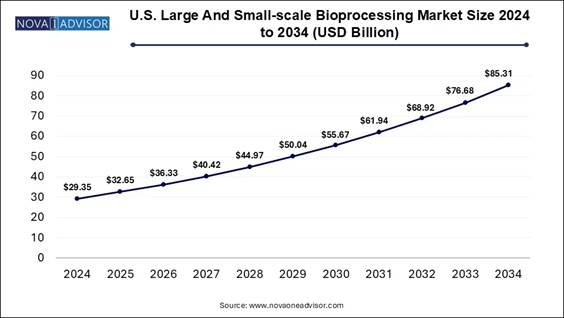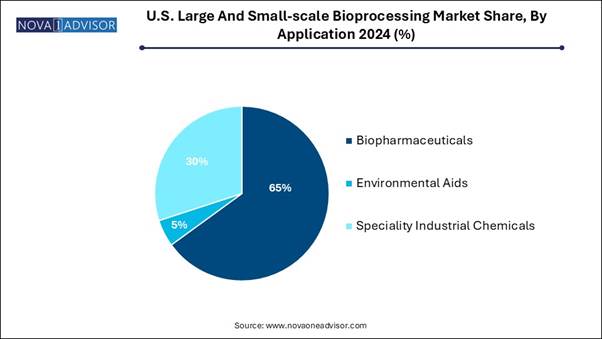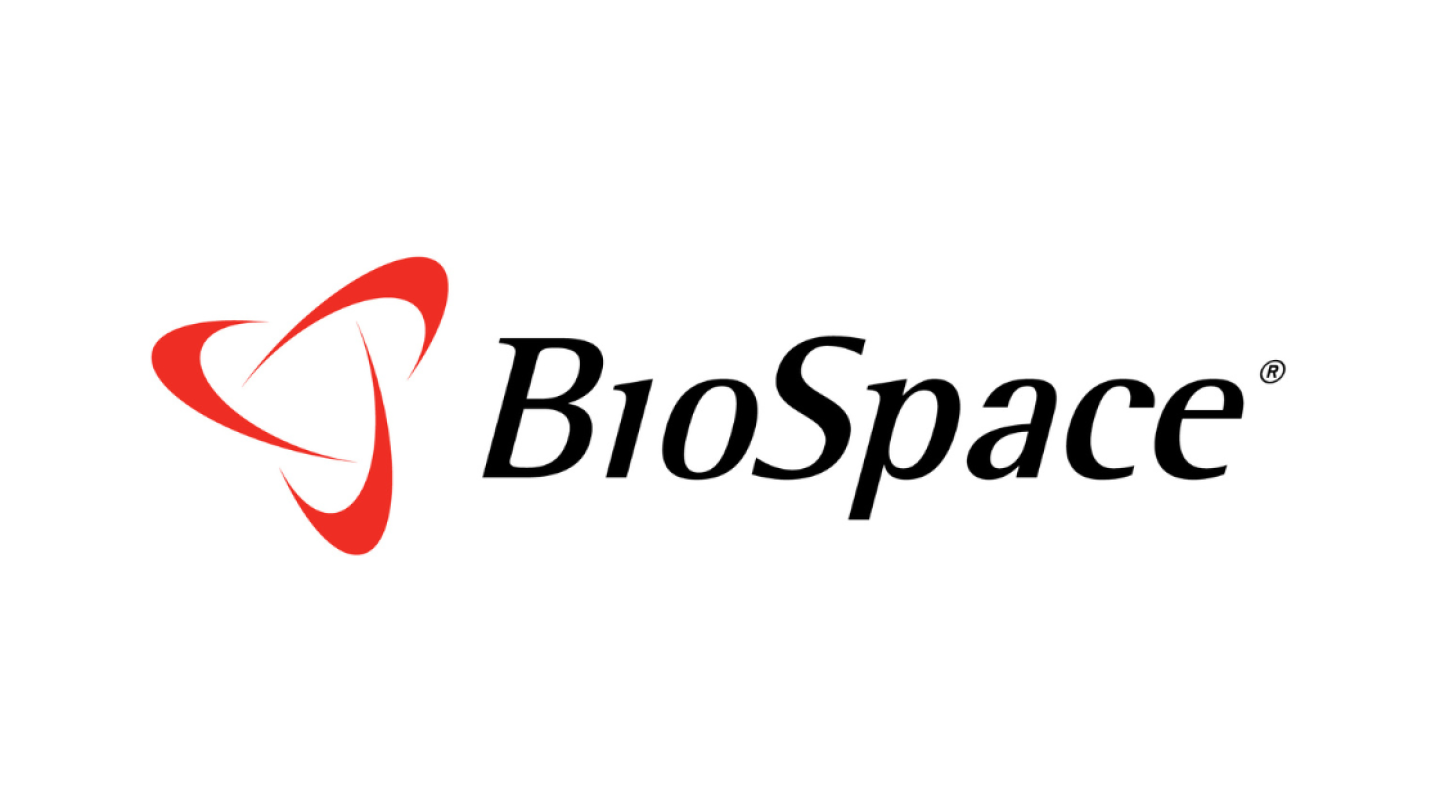According to Nova One Advisor, the U.S.
large and small-scale bioprocessing market size is calculated at 29.35
billion in 2024 and is projected to surpass USD 85.31 billion by 2034 with a
remarkable CAGR of 11.26% from 2024 to 2034.

The U.S. large and small-scale bioprocessing market is
expanding because they are a primary source of major drugs and biologics
essential for medical treatments and scientific research, and development.
Significant pharma product derived from living organisms such as recombinant
proteins, tissues, cells, genes, blood components, allergens, and vaccines.
It comprises the cultivation and manipulation of
bioprocessing systems on a small and large scale to attain particular
industrial or scientific objectives. With this bioprocessing, the biotech
sector can contribute to the progress in different fields, from the food
industry and the production of biomass to the novel drug development sector.
The Complete Study is Now Available for Immediate Access
| Download the Sample Pages of this Report@ https://www.novaoneadvisor.com/report/sample/9182
U.S. Large and Small-scale Bioprocessing Market Highlights:
• By scale, the industrial scale segment dominated the
market with the largest share in 2024.
• By scale, the small-scale segment is expected to show the
fastest growth over the forecast period.
• By workflow, the downstream processing segment held the
largest market share in 2024.
• By workflow, the fermentation segment is expected to
register significant growth during the forecast period.
• By product, the bioreactors/ fermenters segment captured
the largest market share in 2024.
• By product, the cell culture products segment is expected
to show the fastest growth during the forecast period.
• By application, the biopharmaceuticals segment generated
the highest market revenue in 2024.
• By application, the specialty industrial chemicals segment
is expected to grow at a significant rate over the forecast period.
• By use-type, the multi-use segment accounted for the
highest market share in 2024.
• By use-type, the single-use segment is expected to grow
significantly during the predicted timeframe.
• By mode, the in-house segment dominated the market with
the biggest revenue share in 2024.
• By mode, the outsourced segment is expected to grow at the
fastest CAGR during the forecast period.
Market Size & Forecast
⬥︎
2024 Market Size: USD 29.35 Billion
⬥︎
2034 Projected Market Size: USD 85.31 Billion
⬥︎
CAGR (2025-2034): 11.26%
⬥︎
North America: Largest market in 2024
Market Overview and Industry Potential
The U.S. large and small-scale bioprocessing market is
expanding rapidly due to bioprocessing
is the management of naturally occurring living organisms and systems by
bioengineers to attain industrial and research goals. The U.S. has an
unparalleled ability to grow, store, harvest, and transport bioprocessing
products on a large scale. Increasing government support for small- and
large-scale bioprocessing, for instance, in 2023, the President’s commitment to
grow the bioeconomy spurred $46 billion in public and private sector
biomanufacturing investments for projects in the country.
Immediate Delivery Available | Buy This Premium Research https://www.novaoneadvisor.com/report/checkout/9182
Top Used Bioprocesses Across the Globe:
Processes
Application
Bioreactor
operation
It ensures an
ideal environment for cell growth and the synthesis of desired bioproducts,
enabling the optimization of bioprocesses and reducing costs.
Upstream
bioprocessing
This process
helps to develop therapeutic proteins, stem cells, and viruses.
Fermentation
Optimization
of fermentation and bioprocessing is crucial to maximize production and
improve the efficiency of these processes.
Distillation
It is not
only used for product recovery but also for product purification.
Chromatography
Chromatography
is a powerful technique for the separation and purification of products.
U.S. DOE about Biotech Sector:
The U.S. Department of Energy (DOE) is initiating to use of biotechnology
and biomanufacturing to enhance the lives of U.S. people and is taking
significant steps to advance the National Biomanufacturing and Biotechnology
Initiative. Increasing government funding for advanced biomanufacturing.
•For instance, in August 2024, the US Department of
Agriculture is assuring a $25 million loan for a contract fermentation facility
Liberation Labs is building in Indiana, which will contribute to the growth of
the market.
• For Instance, In April 2025, Manus, the proven
bioalternatives scale-up platform, and Inscripta, a leading life science
technology company helping to create the bioeconomy, announced a strategic
merger to establish a unique end-to-end platform for scalable development,
biomanufacturing, and commercialization of bioalternative products.
Latest Trends of the Market
⬥︎
In September 2022, the US government invested over $2 billion to launch its
biomanufacturing initiative, whose goal is to expand manufacturing capacity in
the country and ensure pandemic preparedness.
⬥︎
In January 2025, U.S. Department of Agriculture (USDA) Secretary Tom Vilsack
announced that USDA is funding 586 projects to increase access to clean energy
systems and enhance the availability of domestic biofuels. Today, USDA is
providing nearly $180 million through the Rural Energy for America Program
(REAP) and the Higher Blends Infrastructure Incentive Program (HBIIP) with
funding from President Biden’s Inflation Reduction Act, the nation’s
largest-ever investment in combatting the climate crisis.
⬥︎
In May 2025, DuPont expanded its bioprocessing portfolio with the launch of
DuPont AmberChrom TQ1 chromatography resin for the purification of
oligonucleotides and peptides in support of a broad range of biopharma
applications.
Increasing Demand for Biopharma: Market’s Largest
Potential
Growing demand for biopharma products as the U.S. is a
global leader in biopharmaceutical
R&D, around half of the worldwide biopharma R&D activities are
hosted in the U.S. It leads because to its large domestic sector, IP
protections, limits on government drug price setting, supportive science
initiative, and helpful innovation clusters. The U.S. has a long history of
originally leading in progressive industries, only to subsequently lose its
competitive benefits to other countries with more efficient industrial
policies. The US government has recently been threatening a 25% tariff on
pharmaceuticals imported to the US to inspire more biopharma companies to
onshore manufacturing. These tariffs could add up to $750 million in costs,
which contributes to the growth of U.S. large and small-scale bioprocessing.
⬥︎
For Instance, In April 2025, Asahi
Kasei Bioprocess America, Inc. (AKBA), a leader in advanced filtration
and fluid management solutions for the biopharmaceutical industry, was
recognized with the Best Technologies Innovation Award at INTERPHEX 2025. This
recognition was for AKBA’s THESYS Cleavage & Deprotection (C&D) and
Tangential Flow Filtration (TFF) unit, a groundbreaking system redefining
oligonucleotide manufacturing efficiency.
Report Scope of U.S. Large and
Small-scale Bioprocessing Market
Report Coverage
Details
Market Size in 2025
USD 32.65 Billion
Market Size by 2034
USD 85.31 Billion
Growth Rate From 2025
to 2034
CAGR of 11.26%
Base Year
2024
Forecast Period
2025-2034
Segments Covered
Scale, Workflow,
Product, Application, Mode, Use-type
Market Analysis
(Terms Used)
Value (US$
Million/Billion) or (Volume/Units)
Key Companies
Profiled
Avantor, Inc.,
Bio-Synthesis, Inc., Corning Inc., Danaher (Cytiva), Distek, Inc., Entegris,
Eppendorf AG, F. Hoffmann-La Roche Ltd, Getinge AB, Lonza, Meissner
Filtration Products, Inc., Merck KGaA (MilliporeSigma),Thermo Fisher
Scientific, Inc., PBS Biotech, Inc., Repligen Corporation, Saint-Gobain,
Sartorius AG
U.S. Large and Small-scale Bioprocessing Market
Segmentation Analysis:
By Scale Analysis:
The industrial scale segment dominates in the U.S. large and
small-scale bioprocessing market, as this bioprocessing involves the production
of pharmaceuticals, flavours, foods, fuels, and chemicals with the help of a
biocatalyst like an enzyme, microorganisms, plant cells, or animal cells within
a bioreactor. They classically engage in widespread manufacturing, service
provision, or processing, also influencing worldwide sectors and economies.
These industries benefit from economies of scale, allowing them to produce
services or goods more professionally and at minimal expenses compared to
smaller businesses.
On the other hand, the small-scale segment is expected to
grow significantly during the forecast period as it offers increased
flexibility, affordability, and reduced cross-contamination challenges. This
type of manufacturing often contains the application of manual labor and simple
machinery or devices.
By Workflow Analysis:
The downstream
processing segment dominates the U.S. large and small-scale
bioprocessing market, as this processing refers to the series of unit
operations used to separate, purify, and concentrate the product. Downstream
processing also identifies the economic feasibility of the process. The first
operation is cell separation, which is done by cross-flow microfiltration. This
processing generally involves numerous stages, including cell separation,
product recovery, and purification to achieve a high level of product purity.
The fermentation
segment is expected to grow significantly during the forecast period, as it is
suitable for entirely kinds of environments. It is the oldest metabolic process
that is common to prokaryotes and eukaryotes. Fermentation is broadly used in
different industries. Fermentation makes food nutritious, digestible, and
flavoured. Fermentation is an ordinary way of enhancing vitamins, essential
amino acids, anti-nutrients, food appearance, proteins, and improved aroma.
By Product Analysis:
The bioreactors/ fermenters segment captured the largest
market share in 2024, as it is the core of any biologica process in which
microbial, enzymes, plant, or mammalian cell systems are used for the
manufacture of a broad range of valuable biological products. The performance
of any bioreactor is based on many functions, such as biomass concentration and
Sterile conditions. Bioreactors ensure a perfect environment for cell growth
and the synthesis of wanted bioproducts, allowing the optimization of
bioprocesses and lowering costs and production time.
The cell culture products segment is expected to show the
fastest growth during the forecast period, as cell cultures have huge control
of the physicochemical environment, such as pH, temperature, osmotic pressure,
oxygen, and carbon dioxide tension, which can be controlled precisely, and the
control of physiological conditions, which can be constantly examined. Cell
culture is used as an ideal system to study basic cell biology and
biochemistry, to study the interaction among the cells and disease-causing
agents such as viruses, bacteria, and to study the effects of drugs.
By Application Analysis:
The biopharmaceuticals
segment generated the highest market revenue in 2024, as bioprocessing is a
moderately advanced concept in the manufacturing of biopharmaceuticals.
Entirely of the active pharmacological ingredients must be sterile for their
administration. Thus, they must be produced under sterile conditions. It
revolutionizes the massive mainstream biomanufacturing process steps in
accommodations of biopharmaceutical industries. There is high potential in
making processes more affordable due to customization and simplification of
some aspects of bioprocessing technology and reducing the cost of products.

The specialty industrial chemicals segment is expected to
register the fastest CAGR during the predicted timeframe as bioprocesses over
traditional chemical processes require mild reaction conditions, are more
efficient and specific, and produce renewable by-products. The expansion of recombinant
DNA technology has prolonged and extended the potential of
bioprocesses.
By Use-Type Analysis:
The multi-use segment generated the highest market revenue
in 2024, as large-scale multi-use processes are time-saving technologies in the
world. Although they have demonstrated process effectiveness, a company
considers major aspects when acquiring it. Large-scale multi-use processes
often evolve as customized solutions. It requires high capital investment and
operational costs, and the device’s footprint is large.
The single-use chemicals segment is expected to register the
fastest CAGR during the predicted timeframe, as it is alternative solutions
have become available for commercial cell-culture–based manufacturing.
Single-use technology is intended to be disposable, meaning it almost
eliminates the challenges of leftover contamination between manufacturing runs.
By Mode Analysis:
The in-house segment generated the highest market revenue in
2024, as this manufacturing allows for product development as rapidly and as
economically as possible because consumers have control over it. Therefore,
in-house approaches are critical for CGT entrants and drug developers that are
designated to become fully integrated companies.
The outsourced segment is expected to register the fastest
CAGR during the predicted timeframe as outsourcing bioprocess development
provides many advantages. This includes the opportunity and potential to
accelerate the bioprocess development timeline, allowing companies to enter
pre-clinical studies quicker and to enroll their drug in clinical trials in a
time-efficient manner.
Country Level Analysis:
The U.S. is dominant in the market as a presence of robust
product pipelines in gene and cell therapies, tissue engineering, and more is
driving demand for large and small-scale bioprocessing. U.S. government to
build more databases, progress standards, raise R&D funding opportunities,
and increase consumer facilities for scale-up. Increasing government support
from NIH, BARDA, and private investors drives the infrastructure and innovation.
⬥︎
For Instance, In April 2025, Thermo Fisher Scientific
announced a $2 billion investment in US operations over the next four years to
bolster domestic innovation and manufacturing capabilities in the life sciences
sector. According to the company, the investment consists of $1.5 billion in
capital expenditures to expand manufacturing and $500 million towards R&D
aimed at supporting high-impact innovations.
U.S. Large and Small-scale Bioprocessing Market
Companies:
• Avantor,
Inc.
• Corning Inc.
• Danaher (Cytiva)
• Distek, Inc.
• Entegris
• F. Hoffmann-La Roche Ltd
• Lonza
• Meissner Filtration Products, Inc.
• Merck KGaA (MilliporeSigma)
• Thermo Fisher Scientific, Inc.
• Repligen Corporation
• Saint-Gobain
• Sartorius AG
What is Going Around the Globe?
⬥︎
In June 2025, Ecolab Life Sciences launched its new Purolite AP+50 affinity
chromatography resin at the Biotechnology Innovation Organization (BIO)
International Convention, which is being held in Boston. The new resin
optimizes operations during the antibody manufacturing process.
⬥︎
In April 2025, Culture Biosciences, headquartered in South San Francisco,
Calif., announced the launch of Stratyx 250, which the company said in a press
release is the first mobile, cloud-integrated bioreactor that is designed to
provide biotech companies with simultaneous flexibility, automation, and remote
process control.
You can place an order or ask any questions, please feel
free to contact at sales@novaoneadvisor.com
| +1 804 441 9344
Related Report –
⬥︎
U.S. Single-use Bioprocessing Market – https://www.novaoneadvisor.com/report/us-single-use-bioprocessing-market
⬥︎
Single-use Bioprocessing Market – https://www.novaoneadvisor.com/report/single-use-bioprocessing-market
⬥︎
India Single-use Bioprocessing Probes And Sensors Market – https://www.novaoneadvisor.com/report/india-single-use-bioprocessing-probes-and-sensors-market
⬥︎
Single-use Bioprocessing Probes & Sensors Market- https://www.novaoneadvisor.com/report/single-use-bioprocessing-probes-sensors-market
⬥︎
Single-use Bioprocessing Probes And Sensors Market – https://www.novaoneadvisor.com/report/single-use-bioprocessing-probes-and-sensors-market
⬥︎
Continuous Bioprocessing Market – https://www.novaoneadvisor.com/report/continuous-bioprocessing-market
Segments Covered in the Report
This report forecasts revenue growth at country levels and
provides an analysis of the latest industry trends in each of the sub-segments
from 2021 to 2034. For this study, Nova one advisor, Inc. has segmented the
U.S. large and small-scale bioprocessing market.
By Scale
• Industrial Scale (Over 50,000 Liter)
• Small Scale (Less Than 50,000 Liter)
By Workflow
• Downstream Processing
• Fermentation
• Upstream Processing
By Product
• Bags & Containers
• Bioreactors/Fermenters
• Bioreactors Accessories
• Cell Culture Products
• Filtration Assemblies
• Others
By Application
• Biopharmaceuticals
• Environmental Aids
• Speciality Industrial Chemicals
By Use-Type
• Multi-Use
• Single-Use
By Mode
• In-House
• Outsourced
Immediate Delivery Available | Buy This Premium Research https://www.novaoneadvisor.com/report/checkout/9182
About-Us
Nova One Advisor is a global leader in market
intelligence and strategic consulting, committed to delivering deep,
data-driven insights that power innovation and transformation across
industries. With a sharp focus on the evolving landscape of life sciences, we
specialize in navigating the complexities of cell and gene therapy, drug
development, and the oncology market, enabling our clients to lead in some of
the most revolutionary and high-impact areas of healthcare.
Our expertise spans the entire biotech and
pharmaceutical value chain, empowering startups, global enterprises, investors,
and research institutions that are pioneering the next generation of therapies
in regenerative medicine, oncology, and precision medicine.
Web: https://www.novaoneadvisor.com/
Contact Us
USA: +1 804 420 9370
Email: sales@novaoneadvisor.com
For Latest Update Follow Us: LinkedIn
